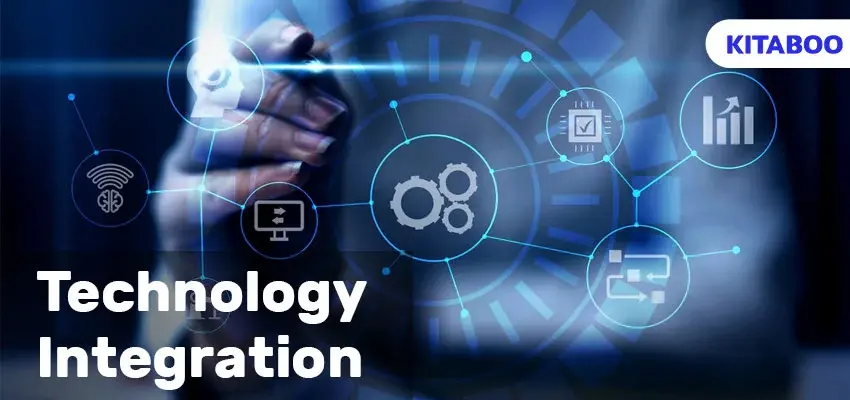
Beyond Buzzwords: Demystifying Technology Integration in Education
Summarize this blog with your favorite AI:
Technology integration and blended learning in educational systems is a combination of online activities and face-to-face teaching. This hybrid learning methodology includes the incorporation of various technological tools, resources, and methods into the teaching and learning process.
The essence of seamlessly integrating technology into educational environments is to enhance educational outcomes, work on curriculum and instructional strategies, and create a more dynamic and interactive learning environment. The goal is to leverage technology to support and enhance the educational experience for both educators and students.
However, several buzzwords or jargon can make technology integration in education a complicated or complex process. Here is an overview that will comprehensively demystify such buzzwords and provide clarity on seamless system integration.
Table of Contents
I. Scope of Technology Integration in Education
- Curricular Enhancement
- Pedagogical Strategies
- Personalized Learning Opportunities
- Global Access to Information
- Digital Assessment and Feedback
- Professional Development
II. Top 7 Buzzwords Demystified for a Seamless System Integration
- Distributed Cloud
- Artificial Intelligence (AI)
- Digital Textbook Apps
- Extended Reality (XR)
- Sustainable Technology
- Online Assessment Tools
- Digital Resources
III. Conclusion
Scope of Technology Integration in Education
The world of education revolves around advancements in technology in every sphere, content, publishing, teaching, educational resources, and interactive learning processes.
The trend is to collaborate with iconic and well-known digital textbook platforms like KITABOO, which help educational institutes integrate technological trends into their current working culture.
Let us understand the key aspects of technology integration in education, which include:
1. Curricular Enhancement
Using digital resources to integrate technology into the curriculum can enhance and extend learning objectives. This includes introducing interactive multimedia and online content to reinforce traditional educational materials.
2. Pedagogical Strategies
Not only learners, but educators also benefit from the incorporation of technology into teaching methods. It helps them engage with students more effectively and includes interactive and personalized teaching approaches through presentations, virtual simulations, and collaborative online projects.
3. Personalized Learning Opportunities
Technology allows for collaboration with interactive digital textbook platforms like KITABOO that cater to individual student needs and learning styles.
This personalization helps students progress at their own pace and address gaps in understanding. Such adaptive learning platforms and educational apps can cater to individual learning styles and encourage a more tailored educational journey.
4. Global Access to Information
It is of paramount importance for students to deal with real-world issues and have the critical thinking and decision-making skills to assess and resolve global perspectives.
There is an expansive availability of information and educational resources like open book resources, online databases, digital communities, e-books, and educational websites that provide opportunities for comprehensive learning beyond traditional classroom resources.
5. Digital Assessment and Feedback
The mode, style, and format of assessments have changed, and the leaders of educational institutions are adopting more efficient and timely assessment processes.
Automated grading systems can provide instant feedback, recognize areas of improvement, and promote a more responsive learning environment.
6. Professional Development
The essence of technology integration in education, especially for K12 learners, is to promote professional development, settle for the best career choices, and imbibe digital literacy skills necessary for success in the modern workforce.
K12 learners develop critical thinking, problem-solving, and collaboration skills that are essential in today’s digital age. Besides being aligned with future workforce trends, technology integration in education is crucial for enhancing 21st-century skills development that is in high demand in various professions.
Top 7 Buzzwords Demystified for a Seamless System Integration
Let us understand some of the key buzzwords that ensure rigorous technology integration in education:
1. Distributed Cloud
Distributed cloud is one of the most important buzzwords in the educational world that allows storage, access, and interaction of data flexibly and concisely. The educational world revolves around abundant content resources and technologies like cloud storage and cloud computing, ensuring the security and management of computer intelligence.
It can be applied in various use cases and services with its varied range of innovations. For instance, the Learning Management Systems (LMS) offers a centralized hub for digital assignments, blended learning resources, and various course materials, which can be incorporated within the distributed cloud.
2. Artificial Intelligence (AI)
Artificial Intelligence (AI) is the application of human intelligence in machines that leverages machine learning capabilities and natural language processing to uncover fresh insights about various educational models.
Automated intelligence like edge computing, IoT, and ChatGPT have created a buzz around and are some of the most prominent trends in technology.
3. Digital Textbook Apps
Digital textbook apps like KITABOO offer gamified, engaging, and interactive resources that reinforce learning. Trending content creation and distribution, availability of digitalized assessments and curriculum, and collaborative lessons allow teachers and students to interact with digital content in real-time.
Many other collaborative tools offer video classrooms, document editing, and communication tools that make it easy for students to learn at their own pace.
4. Extended Reality (XR)
XR is a buzzword, which is used for educational products that incorporate elements of VR, AR, or MR. This is one of the key technologies that represent advancements in hardware and software and have become quite affordable and accessible to educationists.
VR and AR tools provide immersive learning experiences, allowing students to visualize complex concepts and conduct virtual experiments.
5. Sustainable Technology
Sustainable technology is one of the prime digital solutions that revolve around environmental, social, and governance outcomes.
It largely impacts the educational world, and it has now become a question of credibility, ethics, and integrity for educational institutions to opt for the technologies and tools that deliver maximum growth with no adverse effect on the environment.
6. Online Assessment Tools
These tools allow educators to create and administer assessments online, providing instant feedback and data on student performance. It is a holistic approach to automate real-world formative assessments that optimize decision-making and enhance the capabilities of students.
7. Digital Resources
There are various kinds of digital resources available, like digital textbooks and E-books, that offer a cost-effective and easily accessible alternative to traditional print materials.
Podcasts and videos cover a wide range of subjects, providing supplemental learning materials and diverse perspectives. Language Learning Apps utilize technology to provide interactive lessons, pronunciation practice, and cultural insights.
Further, coding and programming platforms teach technologically advanced skills interactively and engagingly, promoting computational thinking among students. Similarly, inculcating simulations and virtual labs in educational institutions allow students to conduct experiments and explore scientific concepts in a virtual environment.
Conclusion
Effective technology integration in education requires thoughtful planning, ongoing support, and a commitment to achieve educational goals.
It has the potential to transform education and make it more engaging and relevant to the needs of K12 learners. Uncovering the essence of popular buzzwords that promote seamless system integration helps students create a foundation for a more dynamic learning environment.
You can contact the professionals at KITABOO, one of the most popular digital textbook platforms, to enable technology integration in education and to enhance learning in this digitally-inclined educational society.
Also Check:
Discover how a mobile-first training platform can help your organization.
KITABOO is a cloud-based platform to create, deliver & track mobile-first interactive training content.


